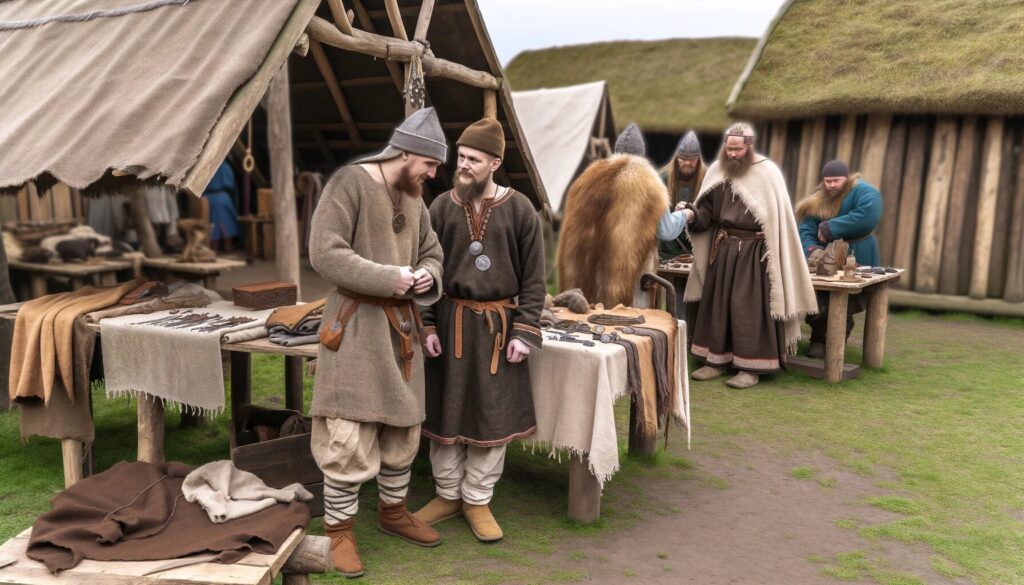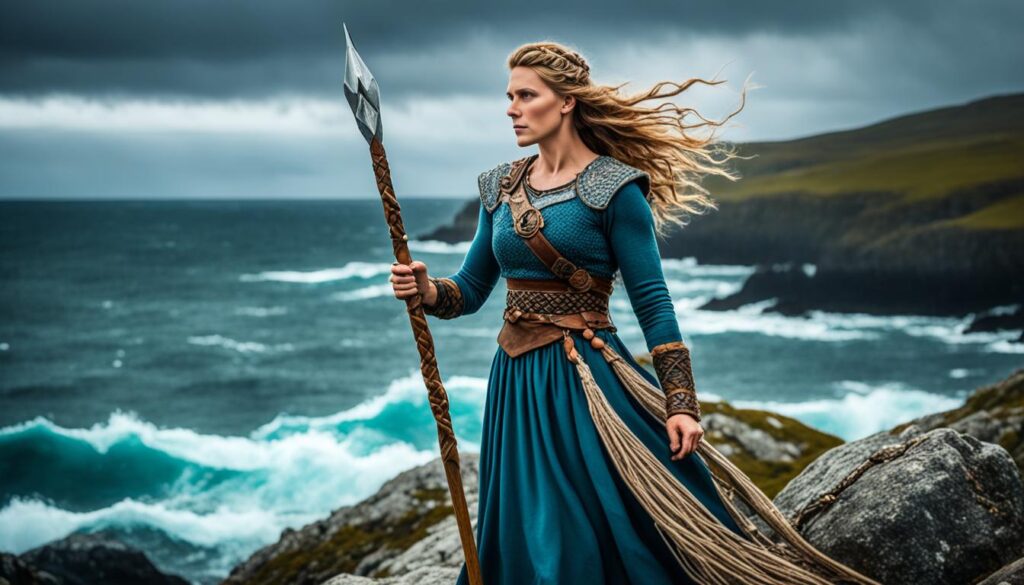Daily Life in the Viking Age, Tales of the Gods, Viking Clothing and Jewelry, Vikings
Did Viking Women Wear Skirts?
In this article, we will dive into the world of Viking fashion and explore the clothing choices of Norse women. One burning question we’ll address is whether Viking women wore skirts. The answer may surprise you. So, get ready to embark on a journey through history and uncover the truth about Viking women’s fashion.
Viking women played a vital role in Norse society, and their fashion choices reflected their practicality and individuality. From dresses to tunics, their wardrobe showcased a diverse range of garments. But what about skirts? Did Viking women embrace this fashion staple? Join us as we delve into the fascinating realm of Viking fashion and examine historical evidence and archaeological findings to determine whether Viking women indeed wore skirts.
Understanding Viking Clothing
Before we delve into Viking women’s fashion, let’s first gain a general understanding of how the Vikings dressed. The Vikings were known for their practical and functional clothing, which was suitable for their rugged lifestyle. Their attire included various types of garments that provided both protection and mobility.
The Vikings, who lived in the Scandinavian region, had a distinctive fashion sense that reflected their cultural values and environmental conditions. Their clothing choices were influenced by factors such as Norse mythology, the harsh Scandinavian climate, and their need for practicality in daily life.

The Viking dress was designed to accommodate their active lifestyle. Men and women wore garments suited for their respective roles, whether farming, hunting, or sailing on their iconic longships.
When it came to Viking attire, layers were key. The Vikings would often wear multiple layers of clothing to provide insulation and protection against the cold. A typical Viking outfit would consist of a tunic, usually made of wool, worn over a shirt or undergarment. The length and style of the tunic varied depending on social status and occasion.
The Vikings would wear additional layers such as cloaks, capes, and shawls for added warmth and versatility. These garments provided protection from the elements and allowed for easy adjustment based on different weather conditions.
Viking footwear was also a crucial part of their wardrobe. Boots made of leather or animal skins were commonly worn to provide durability and insulation. These boots were designed to withstand their environment’s demands, whether traversing rough terrain or walking on icy surfaces.
When it comes to accessories, the Vikings were not shy. They adorned themselves with belts, brooches, and jewelry made from various materials, including precious metals and stones. These embellishments served both practical and aesthetic purposes, highlighting the Vikings’ love for intricate craftsmanship and personal adornment.
Cultural Influences on Viking Fashion
When exploring the fashion choices of Viking women, it’s important to understand the cultural influences that shaped their clothing styles. Viking culture, with its rich history and unique characteristics, played a significant role in determining the fashion preferences of Norse women.
One of the primary sources of influence was Norse mythology. The Vikings drew inspiration from their mythological beliefs and incorporated symbolic motifs into their clothing designs. These motifs often depicted mythical creatures, gods, and legendary stories, adding a distinctive touch to their garments.
Another influential factor was the harsh climate in which the Vikings lived. The cold and unpredictable weather conditions necessitated the use of warm and durable materials, such as wool and animal skins. Viking clothing was designed to provide insulation and protect against the elements, showcasing the practicality and functionality valued by the Norse people.
The Vikings were also known for their seafaring lifestyle, which influenced their clothing style. They incorporated elements from other cultures they encountered during their voyages, blending different clothing traditions to create their unique fashion statements.
Additionally, Viking women’s social status played a role in their fashion choices. Wealthy women had access to luxurious materials and embellishments, allowing them to showcase their prosperity and status through their attire.
By considering these cultural influences, we can better appreciate the intricate details and significance behind Viking women’s fashion choices.
Women’s Clothing in Viking Society
When exploring the fashion choices of Viking women, it’s important to delve into the specific clothing worn by these influential figures in Viking society. Viking women embraced diverse garments that reflected their practical needs and cultural sensibilities. Let’s take a closer look at the types of clothing that adorned Viking women in their daily lives.
One of the most prominent garments worn by Viking women was the dress. Dresses were a staple in Viking fashion, exhibiting a wide variety of colors, patterns, and embellishments. These dresses were typically made of wool or linen and designed to emphasize the wearer’s beauty and elegance. Some dresses featured intricate embroidery and decorative trimmings, highlighting the craftsmanship and attention to detail that went into their creation.
In addition to dresses, Viking women commonly wore tunics. Tunics were versatile garments that provided both comfort and functionality. They were often made of lightweight materials and had a loose-fitting design, allowing for ease of movement. Viking women would often layer their tunics with other garments to adapt to changing weather conditions or social occasions.
Aprons were another essential element of Viking women’s clothing. Aprons served a practical purpose, protecting the dresses and tunics from dirt and wear. They were typically made of linen or wool and featured practical pockets for holding various small items.
And of course, we cannot forget the skirts. Skirts were indeed a part of Viking women’s attire. These skirts were typically worn under the dresses and served to add volume and shape to the overall silhouette. They were often made of linen or wool and were intricately pleated for a more stylish appearance.
Ultimately, the clothing worn by Viking women encompassed a range of garments, including dresses, tunics, aprons, and skirts. These garments showcased the fashion sense of Viking women and served their practical needs in the active and diverse Viking society.
The Versatility of Viking Dresses and Tunics
When it comes to Viking fashion, dresses and tunics played a crucial role in the wardrobe of Viking women. These garments were not only stylish but also highly versatile, suitable for a variety of occasions. Whether attending a feast, working around the homestead, or partaking in religious ceremonies, Viking women had the perfect attire to express their fashion sensibilities.
The Viking dress, known as the kyrtill, was a loose-fitting garment that fell just below the knees. It was made from wool or linen and featured a fitted bodice and wide sleeves. The dress could be worn on its own, showcasing its elegance and simplicity, or paired with accessories such as brooches and belts to add a touch of personal style. Viking women often adorned their dresses with embroidery or intricate patterns, further enhancing their beauty.
On the other hand, Tunics were another staple in the Viking women’s wardrobe. These versatile garments could be worn as standalone dresses or paired with a dress for added layers. Tunics were usually knee-length and made from the same materials as dresses. They featured a simple design with short sleeves, making them ideal for everyday wear or as an additional layer during colder seasons.
The combination of dresses and tunics allowed Viking women to create different looks for various occasions. They could wear a dress for a formal gathering or layer a tunic with a dress for added warmth and modesty. These garments’ versatility showcased their practicality and reflected the fashion-forward nature of Viking women.
Accessorizing was another way Viking women expressed their individual style. They would complement their dresses and tunics with belts, brooches, and jewelry, further enhancing their ensemble. These accessories added a touch of flair and served functional purposes, such as holding garments in place.
Whether attending a festive celebration or working on daily tasks, Viking women understood the importance of dressing appropriately. Their choice of dresses and tunics allowed them to navigate different occasions with style and grace. From the simplicity of a dress to the versatility of a tunic, Viking fashion embodied both functionality and aesthetics.
Next, we will explore the mystery of Viking skirts, addressing whether Viking women indeed wore this particular garment and unraveling the truth behind their fashion choices.
Unraveling the Mystery of Female Viking Skirts
Throughout history, Viking culture has captivated the imagination with its tales of conquest and exploration. Yet, one question remains: Did Viking women wear skirts? Let’s dive into historical evidence and archaeological findings to uncover the truth about the presence of skirts in Viking female attire.
While Viking women’s clothing has been historically overshadowed by their male counterparts, recent research sheds light on their fashion choices. It is important to note that Norse fashion was highly influenced by practicality and functionality.
Archaeological discoveries, such as well-preserved textiles, have revealed valuable insights into Viking women’s clothing. These findings indicate that Viking women did indeed wear skirts as part of their female attire. Skirts were typically made from woven materials, showcasing the skill and craftsmanship of Viking weavers.
Skirts in Viking culture were not confined to a single style. Different regions and time periods witnessed variations in skirt length, shape, and embellishments. Some skirts were ankle-length, while others reached mid-calf, catering to the practical needs of Viking women.
The functionality of skirts cannot be overlooked. They allowed for ease of movement, essential for everyday tasks and activities. Skirts provided freedom and flexibility, enabling Viking women to engage in agricultural work, chores, and even combat, if necessary.
It is important to remember that Viking fashion was not restricted to skirts alone. As we further explore Viking women’s fashion, we will discover the diverse array of garments they adorned, ranging from dresses and tunics to aprons and more.
Did Vikings Wear Kilts?
There is often confusion surrounding kilts when it comes to Viking clothing. While kilts are commonly associated with Scottish culture, it’s important to differentiate between the clothing of Vikings and other cultures. Vikings had unique clothing styles that reflected their Norse heritage and practical needs.
Historical evidence and archaeological findings indicate that Vikings did not typically wear kilts. Instead, their attire consisted of garments such as tunics, dresses, trousers, and aprons. The Vikings crafted their clothing with functionality in mind, suitable for their demanding lifestyle of sailing, raiding, and farming.
While the Scottish kilt has become a symbol of Celtic culture, it did not exist during the Viking era. The kilt as we know it today evolved in Scotland centuries later. It’s important to refrain from associating kilts with Vikings, as it can lead to misconceptions and inaccuracies.
To provide a visual representation of Viking clothing, here is an image:

Types of Viking Garments
The clothing worn by Vikings varied depending on the climate and their specific roles. Here are some key types of garments commonly worn by Viking men and women:
- Tunics: These knee-length garments, typically made of wool or linen, were worn by both men and women.
- Dresses: Viking women often wore ankle-length dresses, which were loose-fitting and made of linen or wool.
- Trousers: Both men and women wore trousers for everyday activities. These trousers were typically made of wool.
- For added protection and functionality, Viking women often wore aprons over their dresses.
By understanding the diverse range of garments worn by Vikings, we can appreciate the complexity and ingenuity of their clothing style. While kilts may not have been a part of Viking attire, their fashion choices were both practical and culturally significant.
The Role of Skirts in Viking Fashion
One question that often arises when discussing Viking women’s fashion is the role of skirts in their attire. While it is true that Viking women wore a variety of garments, including dresses, tunics, and aprons, the presence and significance of skirts in their wardrobe is a topic of interest.
To understand the role of skirts in Viking fashion, we must consider the practicality and functionality they offer. Skirts provided freedom of movement, allowing Viking women to easily engage in their daily tasks and activities. Skirts offered a comfortable and flexible option, whether working on the farm, tending to household chores, or participating in social gatherings.
Skirts complemented Viking women’s overall outfits, adding layers and texture to their ensembles. They could be worn alone or with other garments, such as tunics or dresses, creating a layered look that provided both style and warmth. Skirts were often crafted from wool or linen, ensuring durability and comfort in various weather conditions.
One significant advantage of skirts in Viking fashion was their versatility. Depending on the occasion, skirts could be paired with different tops and accessories, allowing Viking women to customize their outfits. This adaptability made skirts a practical and essential component of their wardrobe.
When considering the role of skirts in Viking fashion, it is important to remember that Norse women valued both style and practicality. Skirts offered a balance between these two factors, contributing to Viking women’s overall fashion choices.
How Did Vikings Actually Dress?
Understanding the attire and clothing habits of Vikings, including Viking women, provides captivating insights into their unique dress style. By analyzing various sources and historical records, we can paint a clearer picture of how the Norse people adorned themselves.
Vikings were known for their practical and functional clothing, designed to withstand their rugged lifestyle. Their garments reflected their culture, climate, and the need for mobility and protection. Viking fashion was a blend of style, craftsmanship, and functionality, showcasing their exceptional craftsmanship.
Women in Viking society had a diverse wardrobe that extended beyond traditional skirts. The dress style encompassed various garments, ranging from dresses and tunics to aprons and skirts. Viking women embraced versatility, layering garments together for different occasions and weather conditions. The clothing choices of Viking women were not only a reflection of their practical needs but also a means of expressing their fashion sense.
Archaeological findings and historical records provide invaluable insights into the clothing habits of Viking women. These sources help us understand the specific dress style of Viking women, allowing us to visualize their attire and appreciate the intricate details and craftsmanship involved.
To illustrate the dress style of Vikings further, let’s take a closer look at this representation of Viking women’s attire:

This image showcases a Viking woman wearing a variety of garments, including a dress, tunic, and accessories. Each element of her ensemble uniquely demonstrates the fashion choices and clothing habits of Viking women.
In the next section, we will explore the range of clothing options available to Viking women, going beyond skirts to fully understand the depth and diversity of their fashion choices.
Women’s Clothing: More Than Just Skirts
Viking women’s fashion was not limited to skirts. While skirts were a part of their wardrobe, Viking women had diverse clothing choices showcasing their fashion sensibilities. Let’s explore the complete wardrobe of Viking women and discover the wide variety of garments they wore.
One key clothing item worn by Viking women was the dress. Dresses were versatile and could be tailored in various styles, emphasizing both practicality and aesthetic appeal. They were often made from wool or linen, providing warmth and comfort in the harsh Nordic climate.
Another essential garment in Viking women’s clothing was the tunic. Tunics were typically worn as an underlayer and offered additional protection against the elements. Viking women would layer their tunics with dresses or other garments, creating a visually appealing and functional ensemble.
In addition to dresses and tunics, Viking women adorned themselves with aprons, which served both decorative and practical purposes. The aprons were usually made from colorful fabrics and featured intricate embroidery, showcasing the craftsmanship and attention to detail that Viking women valued.
Accessories played a significant role in Viking women’s fashion as well. They would adorn themselves with brooches, beads, and belt buckles, adding a touch of elegance and personal style to their outfits. These accessories were often intricately designed, showcasing the artistic skills of the Norse people.
Key Takeaways:
- Viking women’s fashion extended beyond skirts, encompassing a wide range of garments.
- Dresses, tunics, and aprons were among the key clothing items in their wardrobe.
- Accessories such as brooches, beads, and belt buckles added a touch of style and individuality to their outfits.
By exploring the complete wardrobe of Viking women, we gain a deeper understanding of their fashion choices and the cultural significance attached to their clothing. Viking women’s fashion was diverse and practical and reflected the unique cultural milieu of the Norse people.
Conclusion
After an in-depth exploration of Viking women’s fashion, we have concluded that skirts were present in their wardrobe. Historical evidence and archaeological findings have made it clear that Viking women did indeed wear skirts as part of their attire. These skirts were essential in their fashion choices, highlighting their unique style and cultural influences.
By examining the clothing habits of Viking women, we have gained valuable insight into their diverse fashion choices. Beyond skirts, Viking women adorned themselves with a range of garments, including dresses, tunics, and aprons. Their clothing reflected both practicality and fashion sensibilities, displaying their adaptability to various occasions and their understanding of the importance of functionality in their rugged lifestyle.
Our exploration of Viking women’s fashion has allowed us to appreciate their cultural influences and bold fashion statements. The Norse women’s fashion choices were not merely limited to practicality; they possessed a keen aesthetic sense that showcased their individuality within Viking society. As we delve into the fascinating world of Viking fashion, we unravel the hidden stories of these remarkable women who left their mark on history.

